Contents
Market Overview
Macro Review
Global growth takes a knock as the delta variant spreads. Renewed lockdowns now extend from Australia to Indonesia to South Korea, just as Japan introduced a state of emergency prior to the Olympic Games. China’s economic surprise index weakened further into negative territory after softer Caixin PMIs, crackdown concerns and a dovish PBoC, which adds another dimension to the 2Q GDP release next week. The 50bps RRR cut buoyed sentiment as high beta names rallied, which saw CNH initially spike above 6.50. Risk markets traded nervously all week, with the VIX briefly up to 21% as 10yr U.S. Treasuries touched 1.25%. U.S. Treasuries did settle 8bps tighter on the week, with the 10yr at 1.34% and 5s30s at 119bps. FOMC minutes revealed little new in the Fed’s thinking, however markets began to react to weaker U.S. ISM Services. On the topic of central banks, the ECB made some movement in allowing inflation to overshoot its 2% mandate, although the policy review will extend to July 22. Elsewhere oil traded up to 6yr highs as OPEC+ failed to agree on production cuts, but weakened on global growth concerns and elevated risks around a price war between UAE and Saudi Arabia.
EM Credit Update
EM sovereign credit ended the week up 0.3% with spreads 9bps wider. U.S. Treasuries tightened 7-9bps, which explains the underperformance in EM spreads, but allows for a grind in spreads through July. In secondary markets, Tajikistan, Cameroon and Croatia outperformed, while Zambia, Slovakia and Tunisia lagged.
The Week Ahead
U.S. earnings will kick off in earnest next week, although G10 central banks will feature heavily in the calendar too. U.S. CPI is due on Tuesday, which is the day before Powell’s testimony in front of the House Financial Services Committee. The Bank of Japan is expected to unveil its green investment program and is also likely to trim its growth forecast. South Korea (BoK), New Zealand (RBNZ) and Canada (BoC) are expected to keep rates unchanged in DM. We would expect a similar outcome across EM with Turkey (19.0%), but the risks of Chile (0.5%) hiking 25bps are rising. After China’s RRR cut and softer inflation, export growth will be in focus, which is also expected to moderate to 22% y/y before the 2Q GDP release (consensus is 8.0%). Retail sales are expected to come in at c.11%, with industrial production at 8% y/y too. Speaking of industrial production, Mexico will publish data along with the Euro-area.
Highlights from emerging markets discussed below include: China continues to fine tune policy with a 50bps RRR cut; Finance Minister reshuffle not likely to change Sri Lanka’s strong willingness to repay external debt; Oman and IMF staff conclude Article IV review; and Eurobonds unlikely to be excluded from Ethiopia’s debt restructuring.
Fixed Income
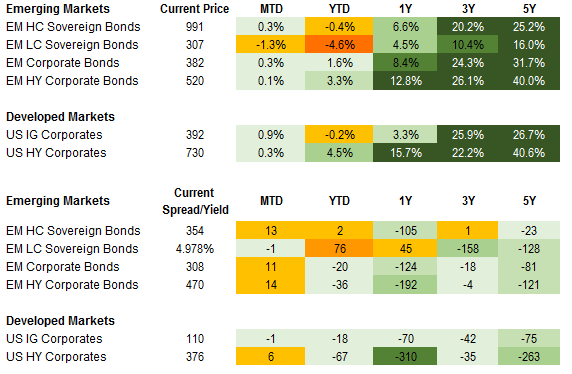
Equities
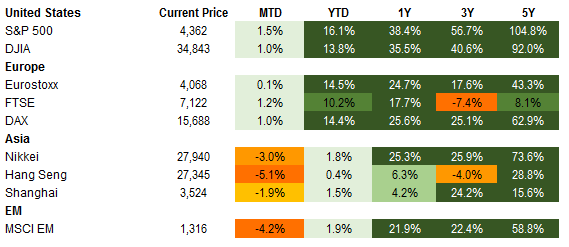
Commodities

Source for data tables: Bloomberg, JPMorgan, Gramercy. EM Fixed Income is represented by the following JPMorgan Indicies: EMBI Global, GBI-EM Global Diversified, CEMBI Broad Diversified and CEMBI Broad High Yield. DM Fixed Income is represented by the JPMorgan JULI Total Return Index and Domestic High Yield Index. Fixed Income, Equity and Commodity data is as of July 9, 2021 (Mid Afternoon).
Emerging Markets Weekly Highlights
China continues to fine tune policy with a 50bps RRR cut
Event: Premier Li Keqiang indicated at a State Council meeting earlier this week that the authorities may use reserve requirement ratios (RRR) and other monetary tools to further offset the impact of rising commodity prices and incrementally tighter financial conditions on manufacturers and SMEs. The commentary was followed by a reduction of 50bps in the RRR rate, applicable to most financial institutions, effective July 15th. The action is expected to result in roughly 1tn yuan in liquidity. Meanwhile, June PMI data reflected easing activity momentum, particularly in services relative to expectations, albeit with the composite Caixin figure remaining in expansionary territory at 50.6.
Gramercy Commentary: We anticipate that the authorities will continue to leverage the monetary tools at their disposable to manage liquidity and the economic recovery in a targeted and tailored manner. The RRR cut should, on the margin, improve credit availability and partially offset some of the tightening endured in 1H as well as sizeable upcoming maturities of the Medium-Term Lending Facility. This statement follows a recent RRR hike for foreign currency deposits as well as rhetoric aimed at taming FX appreciation and retaining competiveness. The combination of policy actions are a reflection of the nature of China’s recovery where the external sector outperformed while segments of the domestic economy’s progress have been more impacted by elevated commodity prices and COVID-19 dynamics. Sustained focus on financial stability and gradual policy normalization should keep measures targeted and incremental with a more neutral stance in 2H relative to 1H.
Finance Minister reshuffle not likely to change Sri Lanka’s strong willingness to repay external debt
Event: Basil Rajapaksa was appointed by his brother, President Gota Rajapaksa, as Sri Lanka’s new Finance Minister. In this role, he replaces another Rajapaksa brother, Mahinda, who remains serving in his capacity as Prime Minister and has now been given the Economic Policy and Planning Ministry.
Gramercy Commentary: The reshuffle at the helm of Sri Lanka’s Finance Ministry from one member of the all-powerful Rajapaksa family to another comes less than three weeks ahead of the government’s July-end Eurobond maturity ($1bn), but we do not think it changes anything in the near-term market story. The authorities’ willingness to service debt obligations remains extremely high, in our view. Importantly, the ability to do so has improved throughout the first half of 2021 by securing various bilateral liquidity lines, most notably a 3-yr $1.5bn swap agreement with the People’s Bank of China (PBoC), among others. We believe Sri Lanka will meet the upcoming July Eurobond maturity in full and on time. In the absence of an IMF program on the horizon that could serve as an investor confidence anchor and relieve liquidity pressures on the government, the authorities are likely to continue with their strategy of maximizing bilateral financing options to support Sri Lanka’s external account dynamics, awaiting a more robust economic and external flows recovery following the pandemic shock. While the recently secured and upcoming external funding sources (i.e. $0.8bn from new IMF SDR allocation) have materially reduced the risk of a sovereign credit event in the near-term, debt sustainability concerns over the medium-term remain. Resolving those concerns will be a function of the pace of economic recovery this year and next as well as the authorities’ willingness to engage in fiscal and external sector reforms, either via homegrown initiatives or potentially in the context of an IMF program.
Oman and IMF staff conclude Article IV review; Government requests technical assistance
Event: The government authorities and IMF team completed the Article IV review with the release of staff level conclusions which commended the authorities for swift management of the pandemic. They also noted substantial improvement in fiscal and external financial balances on the back of higher commodity prices and consolidation efforts, albeit flagging, there is still a high uncertainty to the outlook. Oman has requested technical assistance from the IMF in regards to its medium-term fiscal framework and debt strategy.
Gramercy Commentary: The generally constructive assessment combined with future IMF technical assistance is supportive for the credit but does not carry as much weight as a funded or policy assistance program. We agree with the Fund’s characterization of this year’s fiscal stance and approach as balanced in the context of additional and targeted social support amid challenging domestic social conditions albeit with an estimated 4.3% of GDP adjustment in the non-oil structural primary balance. As emphasized in the Fund’s statement, the strategies underway for economic diversification away from the hydrocarbon sector and development of green resources including wind and solar have the prospects to boost domestic and foreign investment over the medium-term.
Eurobonds unlikely to be excluded from Ethiopia’s debt restructuring
Event: Ethiopia’s Finance Ministry announced this week that it has engaged in negotiations to restructure an additional $1bn of government debt, specifying that those talks do not include the sovereign Eurobonds.
Gramercy Commentary: While the authorities appear reluctant to include their lone outstanding Eurobond ($1bn 6.625% 12/11/2024) in ongoing debt restructuring talks, likely due to concerns about future market access and sovereign rating implications, we do not think they will be able to resist pressure to do so for much longer. The Ethiopian authorities requested and have already received debt relief under the G20 Common Framework that clearly calls for “comparability of treatment” among multilateral, bilateral and private creditors. In fact, following the additional debt-restructuring announcement by the Ethiopian MinFin, the IMF strongly encouraged Ethiopia to swiftly form a creditor committee that would support the delivery of its debt plans, which signals to us that the Fund is eager to see a more holistic approach to Ethiopia’s debt operations. Meanwhile, the U.S. government has imposed sanctions on Ethiopia over the military conflict in its northern Tigray region and alleged grave human rights abuses committed by government forces and their allies, urging the multilateral agencies to reassess their engagement with the current Ethiopian Administration. In addition to complicating the debt-restructuring plans and process even further, such developments are also highlighting significant ESG-related concerns for investors. Last but not least, developments in Ethiopia’s sovereign debt re-profiling under the G20 Common Framework could set an important precedent for treatment of private sector creditors in subsequent similar situations, providing an interesting “litmus test” from a market perspective.
Emerging Markets Technicals
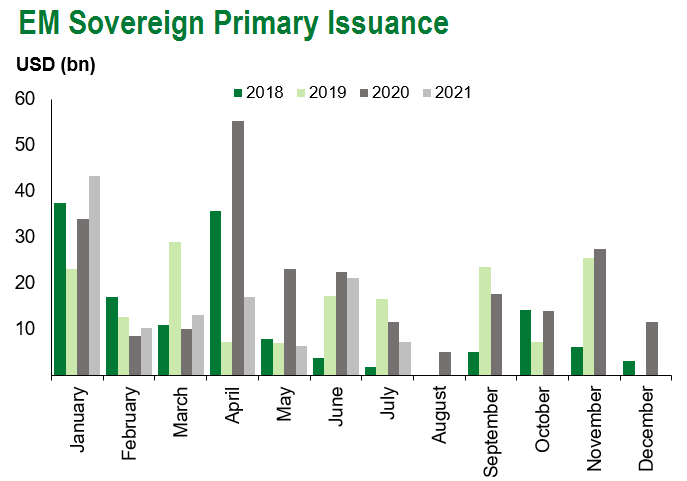
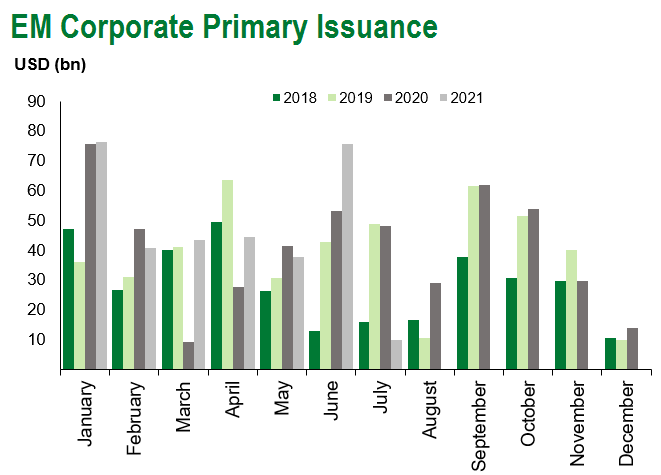
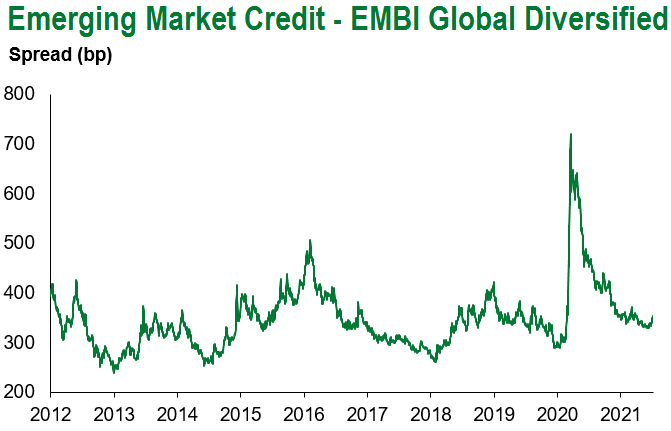
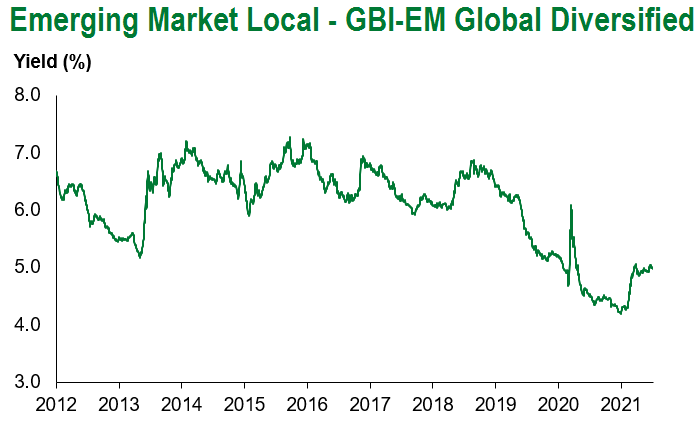
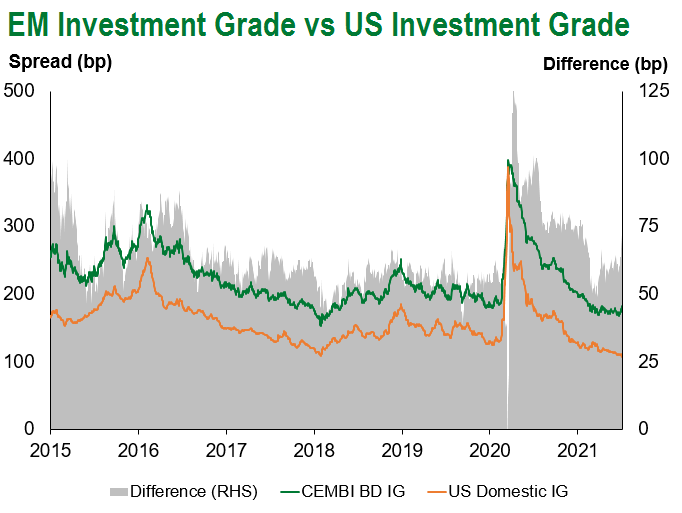
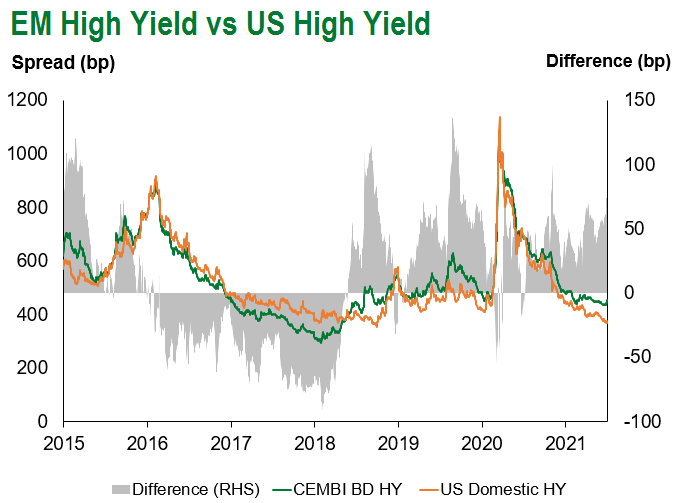
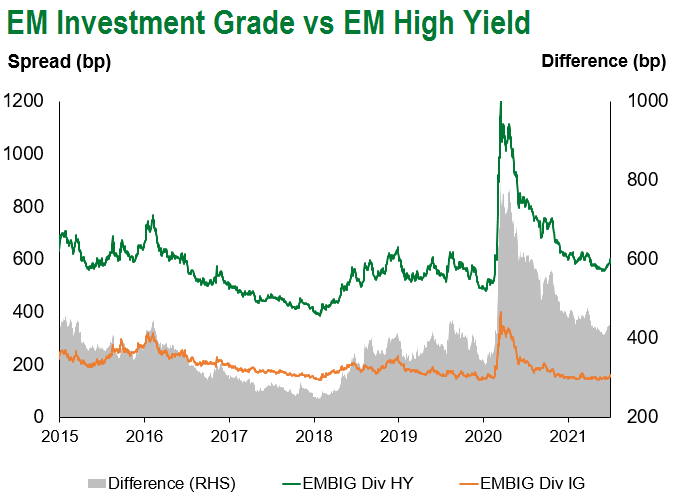
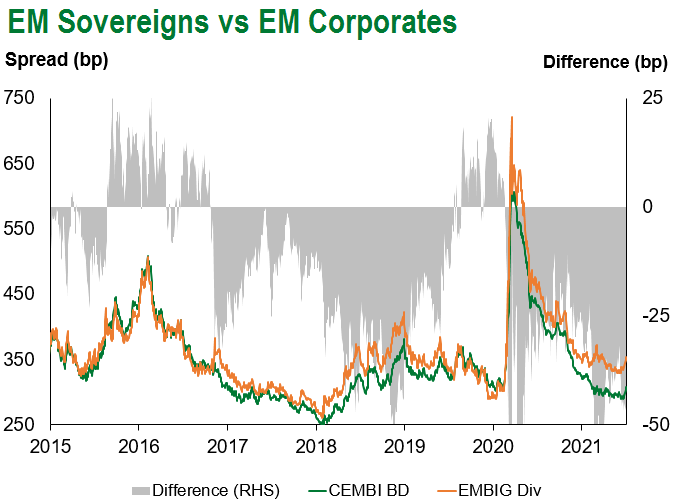
Emerging Markets Flows
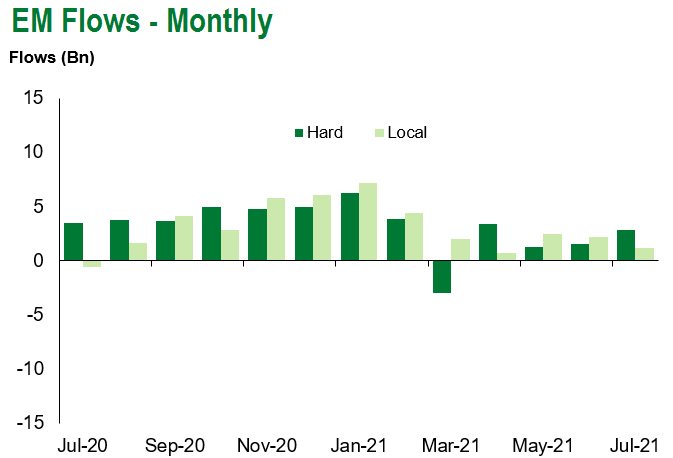
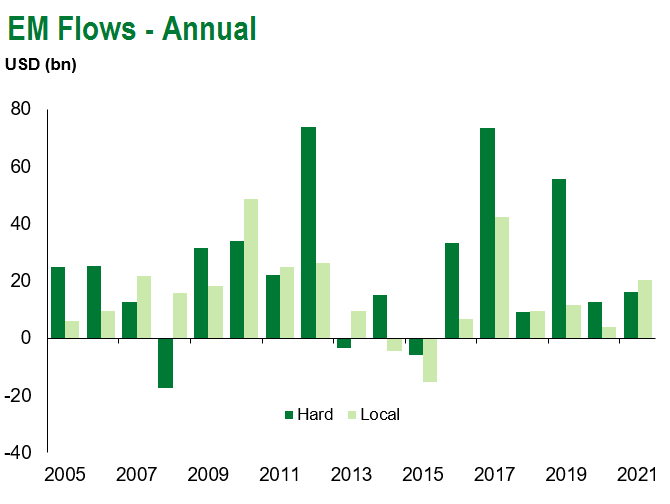
Source for graphs: Bloomberg, JPMorgan, Gramercy. As of July 9, 2021.
COVID Resources
Emerging Markets COVID-19 Case Summary
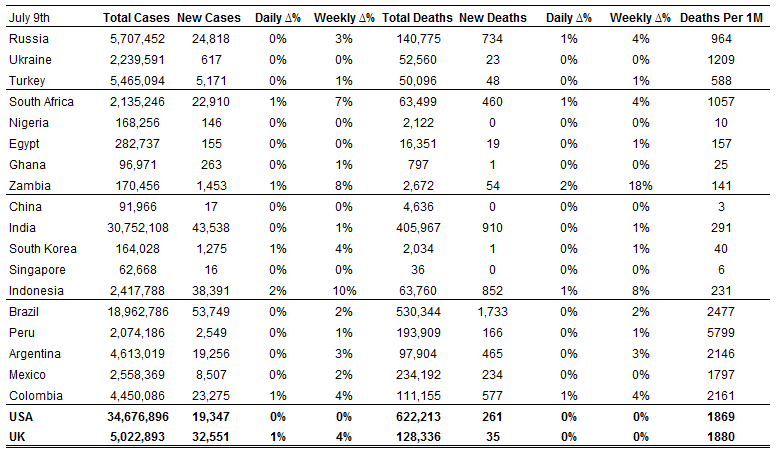
Source: Worldometer as of July 9, 2021.
Additional Crisis Resources:
Johns Hopkins COVID-19 Case Tracker
For questions, please contact:
Kathryn Exum, Senior Vice President, Sovereign Research Analyst, [email protected]
Petar Atanasov, Senior Vice President, Sovereign Research Analyst, [email protected]
Tolu Alamutu, CFA, Senior Vice President, Corporate Research Analyst, [email protected]
James Barry, Vice President, Corporate Research Analyst, [email protected]
This document is for informational purposes only. The information presented is not intended to be relied upon as a forecast, research or investment advice, and is not a recommendation, offer or solicitation to buy or sell any securities or to adopt any investment strategy. Gramercy may have current investment positions in the securities or sovereigns mentioned above. The information and opinions contained in this paper are as of the date of initial publication, derived from proprietary and nonproprietary sources deemed by Gramercy to be reliable, are not necessarily all-inclusive and are not guaranteed as to accuracy. This paper may contain “forward-looking” information that is not purely historical in nature. Such information may include, among other things, projections and forecasts. There is no guarantee that any forecasts made will come to pass. Reliance upon information in this paper is at the sole discretion of the reader. You should not rely on this presentation as the basis upon which to make an investment decision. Investment involves risk. There can be no assurance that investment objectives will be achieved. Investors must be prepared to bear the risk of a total loss of their investment. These risks are often heightened for investments in emerging/developing markets or smaller capital markets. International investing involves risks, including risks related to foreign currency, limited liquidity, less government regulation, and the possibility of substantial volatility due to adverse political, economic or other developments. The information provided herein is neither tax nor legal advice. Investors should speak to their tax professional for specific information regarding their tax situation.